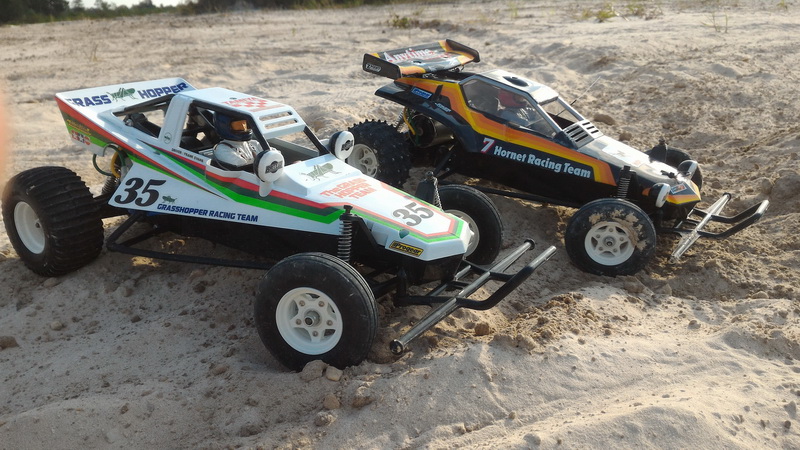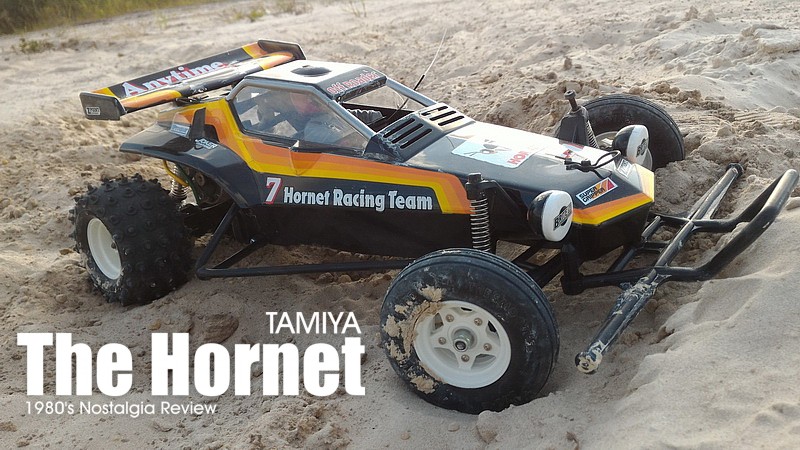
About
It has been almost 32 years when i first caught my eyes on 'THE HORNET' through Tamiya Catalog book. As a kid i always fantasized having a cool R/C models through windows of colored hobby magazine from the 80's. Yes all the hobby stuff i knew came only from printed medias and occasional window shopping passing by local hobby stores with family....i just 'see and drool' only, lol!. My closest thing witnessing and learning technical about R/C hobby was by watching adult bashing R/C buggies at the beach and through my uncle's work table. I was hooked by little tech and engineering into such little plastic models. The first R/C brand i eye on was TAMIYA followed with MARUI and KYOSHO but Tamiya was a big spot light on local scene.
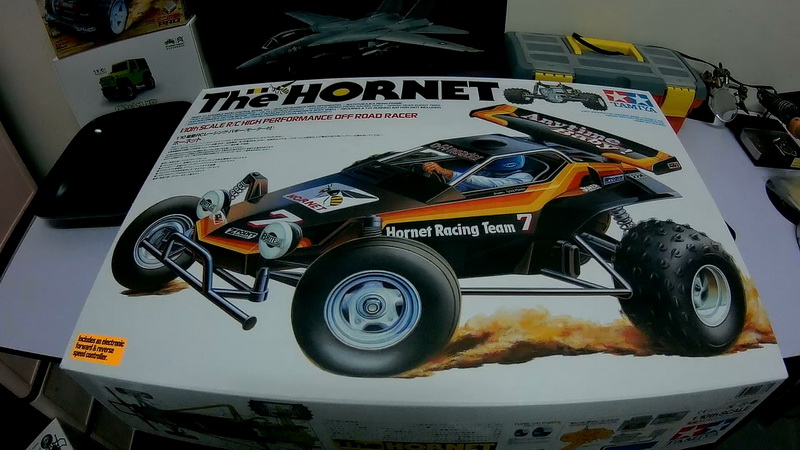
At last in the late 1990's i got hold of TAMIYA Catalog book and expanded my long term wish list. Browsing pictures of exquisite buggies only the FIRE DRAGON and THUNDER DRAGON was my first known hate list and the last was THE HORNET. The first came into my mind when i see it was "That is one fat ugly buggy!" as it lined up along with slender attractive models like THE FOX,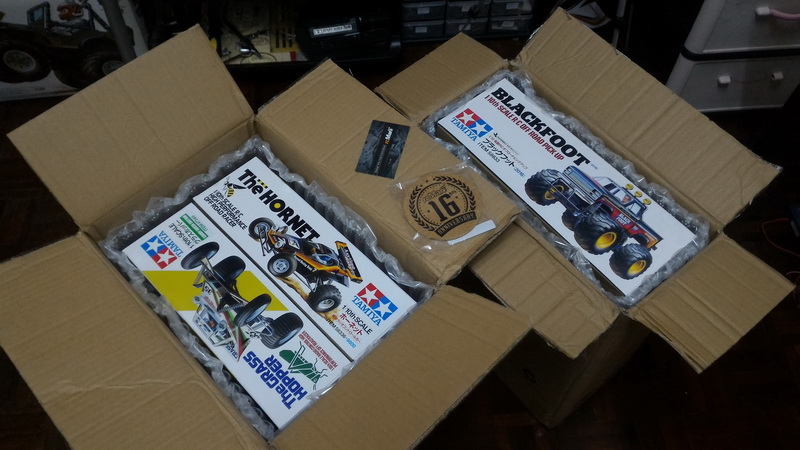 HOTSHOT, GRASSHOPPER, AVANTE and other line ups....it looks so dark and fat! However as time goes by and my appreciation for off-road buggies design grows soon i realized its was a beautiful swan in my eyes. I never consider The Hornet as my future 'must have' in my bucket list but as years passed by and more new 'modern' R/C buggies started to spawn around i realized the Hornet looks 'obviously' cooler than present day buggies. Modern off-road R/C buggies up from year 2010 to present day in 2022 looked like soapy spaceship on wheels which really irked my taste for realistic off-roader and that's how i ended up loving The Hornet more. After graduating with degree and through cycles of careers i finally have one on my hand, a classic Tamiya kits that i once hate but love upon in 1990. It was the best feeling i every had not only because its a must have a Tamiya R/C kit but its a symbolic meaning that i've managed lived through some hardship to become an independent adult and earn my place by enjoying that hobby i dreamed of. If my late mother was around she's definitely not cool with it but life must go on!, lol! Oh btw i bought along with The GRASSHOPPER at the same time since both was cheap and save me shipping costs in bundle. Priced at $90 for a kit it fit well within my budget for my retro R/C project so i can lived up my missing childhood wishes.
HOTSHOT, GRASSHOPPER, AVANTE and other line ups....it looks so dark and fat! However as time goes by and my appreciation for off-road buggies design grows soon i realized its was a beautiful swan in my eyes. I never consider The Hornet as my future 'must have' in my bucket list but as years passed by and more new 'modern' R/C buggies started to spawn around i realized the Hornet looks 'obviously' cooler than present day buggies. Modern off-road R/C buggies up from year 2010 to present day in 2022 looked like soapy spaceship on wheels which really irked my taste for realistic off-roader and that's how i ended up loving The Hornet more. After graduating with degree and through cycles of careers i finally have one on my hand, a classic Tamiya kits that i once hate but love upon in 1990. It was the best feeling i every had not only because its a must have a Tamiya R/C kit but its a symbolic meaning that i've managed lived through some hardship to become an independent adult and earn my place by enjoying that hobby i dreamed of. If my late mother was around she's definitely not cool with it but life must go on!, lol! Oh btw i bought along with The GRASSHOPPER at the same time since both was cheap and save me shipping costs in bundle. Priced at $90 for a kit it fit well within my budget for my retro R/C project so i can lived up my missing childhood wishes.

Specification (as describe by vendor/manufacturer)
Brand name: TAMIYA
Model name: The HORNET
First date production release: 9 Oct 1984
Re-release edition: year 2004
Scale size: 1:10
Chassis type: ABS Plastic Bathtub
Bodyshell: Polycarbonate
Length: 400mm
Width: 230mm
Height: 150mm
Wheelbase: 251mm
Weight: 1.32kg (Without battery)
Drivetrains: 2WD
Motor: 540 Brushed - MABUCHI (*Can easily upgrade to 540 size brushed motor)
Electronic Speed Controller module: Tamiya TBLE-02S (support brushed and sensored brushless)
Front suspension type: Swing arm + Simple King Pin friction shocks struts
Rear suspension type: Integrated gearbox with rigid axle + oil filled shocks struts
Items required to complete the build. (Not included inside the kit)
- Radio transmitter and receiver unit (2 Channel minimum)
- 1x Steering servo (Standard size for 1:10 scale eg; FUTABA S1001)
- 1x battery; 7.2v Sub-C/NimH or 7.4V Li-Po 2200mah~3300mah
- 1x battery charger
- Building tools such as screw driver, cutter and etc
- Tire glue
- Spray paint color code: PS5 'Black' (86005)
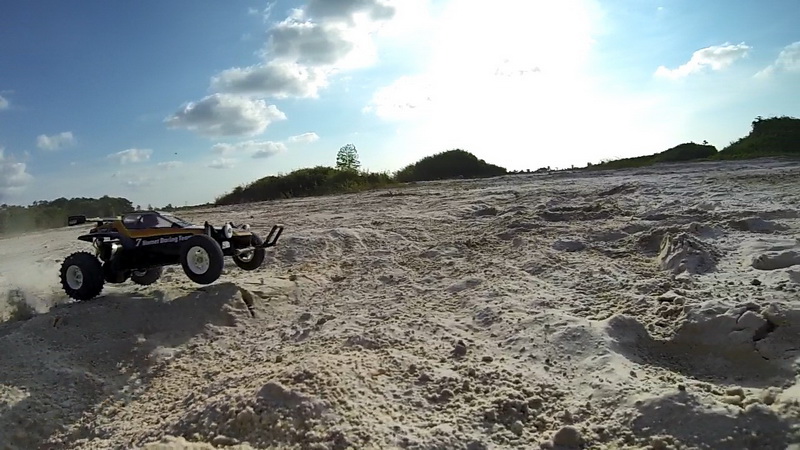
|
Pros:
|
Cons:
|
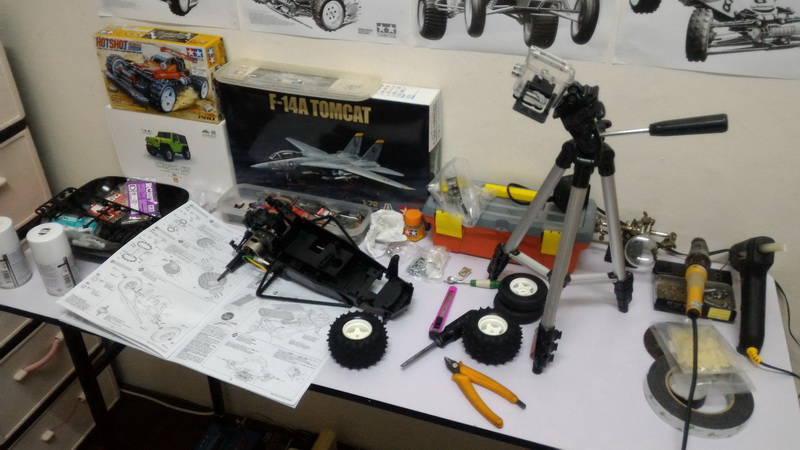
Quality and builds.
I must say first time holding that big Tamiya box the art work on the front is mesmerizing and retro to look at making it looks very premium R/C package. Looks like i bought an Italian art work rather than just toy package. In comparison to the GRASSHOPPER box art the HORNET looks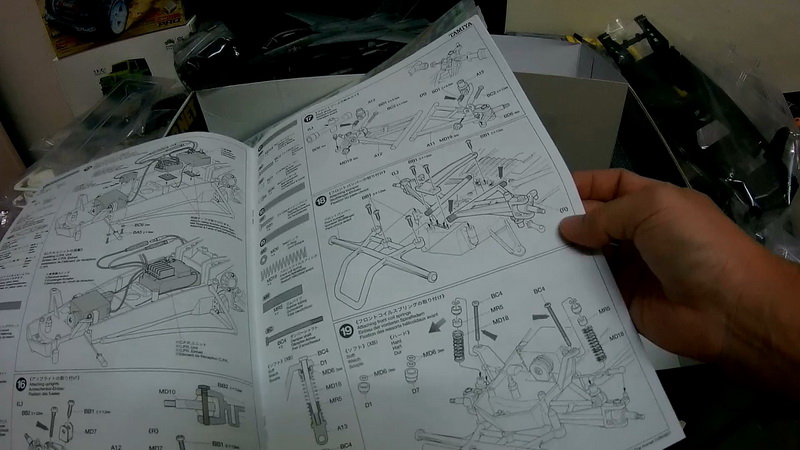 more alluring. Overall that how 80's product art looked like across many branded hobbyist model kit package back in the old days before computer graphics era....its a keeper. Inside are bunch of plastic model kit like parts with part trees and tit bits well arranged in packets and little boxes all well labeled well. The build parts are 95% same as the GRASSHOPPER kit that i reviewed before with advantages having better performance parts which make The HORNET a grade above The GRASSHOPPER. Unlike the Grasshopper that comes with solid white painted hard body shell the Hornet body shell comes in uncut transparent and flexible polycarbonate aka lexan body shell so it takes lots of works on precision cutting the body with sharp knife through different angle and need proper black color spray can finishing. Others in the box kit is manual book, uncut stickers, more plastics, metal parts like screws, nuts, springs, shocks kits, oil and grease.
more alluring. Overall that how 80's product art looked like across many branded hobbyist model kit package back in the old days before computer graphics era....its a keeper. Inside are bunch of plastic model kit like parts with part trees and tit bits well arranged in packets and little boxes all well labeled well. The build parts are 95% same as the GRASSHOPPER kit that i reviewed before with advantages having better performance parts which make The HORNET a grade above The GRASSHOPPER. Unlike the Grasshopper that comes with solid white painted hard body shell the Hornet body shell comes in uncut transparent and flexible polycarbonate aka lexan body shell so it takes lots of works on precision cutting the body with sharp knife through different angle and need proper black color spray can finishing. Others in the box kit is manual book, uncut stickers, more plastics, metal parts like screws, nuts, springs, shocks kits, oil and grease.
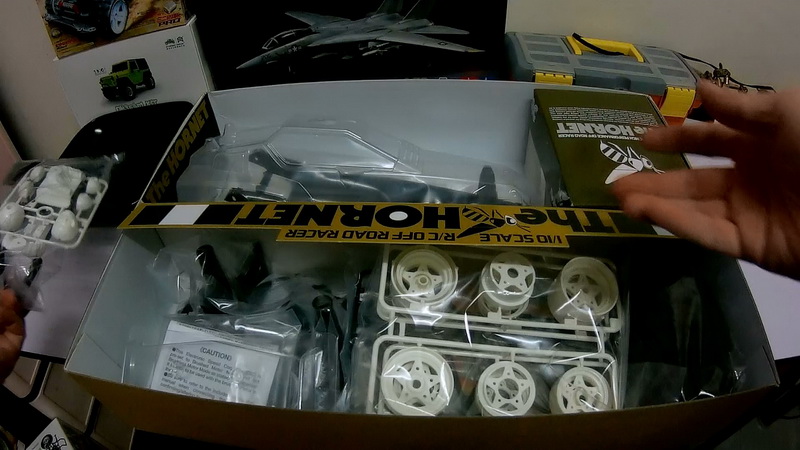
Package also came with modern electronic ESC module (TAMIYA TBLE-02S speed controller) which can support both brushed motor and also sensored brushless motor. In the 80's the ESC originally was a servo actuated mechanical speed controller which have non-proportional stepper style throttle control while 5V BEC was build inside the radio receiver to feed in two servos... old R/C tech days was a struggle. Kit it comes with simple friction bushed bearings to hold most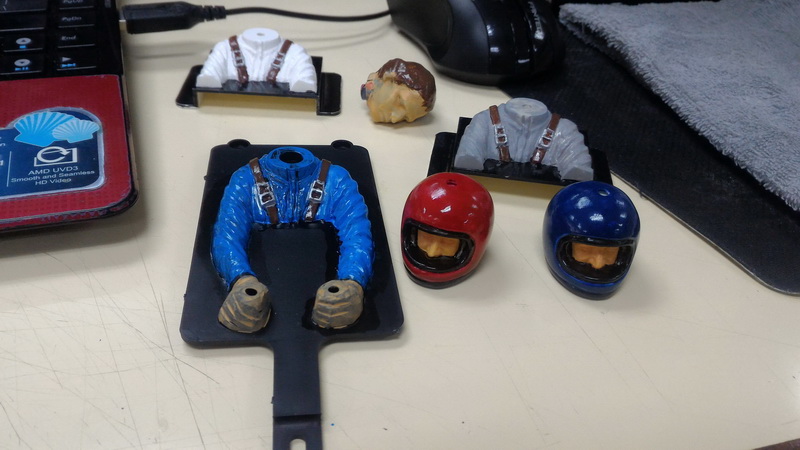 of the moving drivetrains/gear parts and you'll need to supply your own external electronic parts such as 1/10 size (Ref: FUTABA S1001)steering servo, 2S 7.4V Li-po battery pack and radio combo unit to get this kit running on the ground.....oh yes and don't forget extra cans of (Tamiya PS type) paints for body shell finishing too which uses spray paint color code: PS5 'Black' (86005). As for my hand picked electronics assembly that comes from my own pocket i'm using cheap 10kg torque analogue servo, 2s 7.4 2200mah 35c lipo battery and a radio combo of 3CH FLYSKY FS-GT3B to compliment this build.
of the moving drivetrains/gear parts and you'll need to supply your own external electronic parts such as 1/10 size (Ref: FUTABA S1001)steering servo, 2S 7.4V Li-po battery pack and radio combo unit to get this kit running on the ground.....oh yes and don't forget extra cans of (Tamiya PS type) paints for body shell finishing too which uses spray paint color code: PS5 'Black' (86005). As for my hand picked electronics assembly that comes from my own pocket i'm using cheap 10kg torque analogue servo, 2s 7.4 2200mah 35c lipo battery and a radio combo of 3CH FLYSKY FS-GT3B to compliment this build.
*Extra readings: To avoid article repetition; for this article i do not wish to talk much about the The Hornet build because since its similar to 'The Grasshopper' kit i'll let you read the rest of article here: "Nostalgia review: TAMIYA - The GRASSHOPPER 1980's buggy", So get back here when you done reading.......................done? Let's move on.
Here are some highlights of differences which makes The Hornet up its level higher above The Grasshopper despite having same base chassis;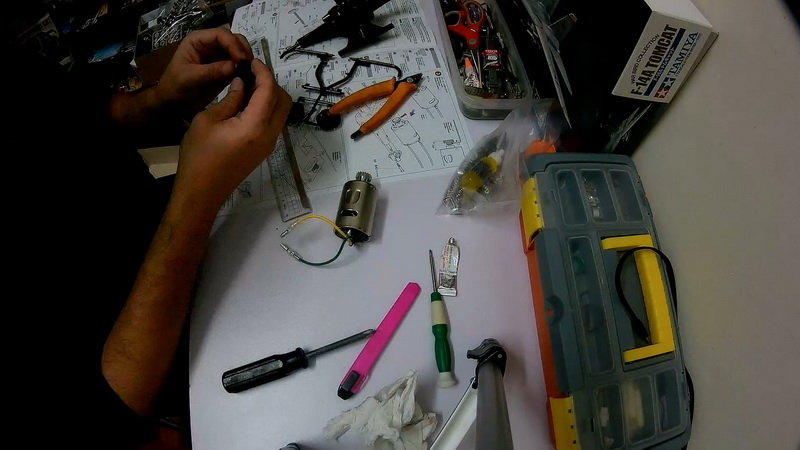
-
It comes with 540 brushed motor
-
Oil filled rear damper shocks.
-
Lightweight polycarbonate bodyshell
Other than that both Hornet and Grasshopper share the same base chassis and gearbox drive system which means the chassis parts and future hop-ups upgrade are interchangeable between them.
The build takes longer than what i did on The Grasshopper because on The Hornet it takes lots of work to cut the body shell, spray the under side of the body and also manually cut the sticker unlike pre-cut sticker sheet. Overall this kit almost aimed for any seasonal builder that works a lot with pen knife and paint works. Its takes slightly 8 hours for me to completely build this kit in a day with coffee breaks in between and waiting for the paint to dry up.
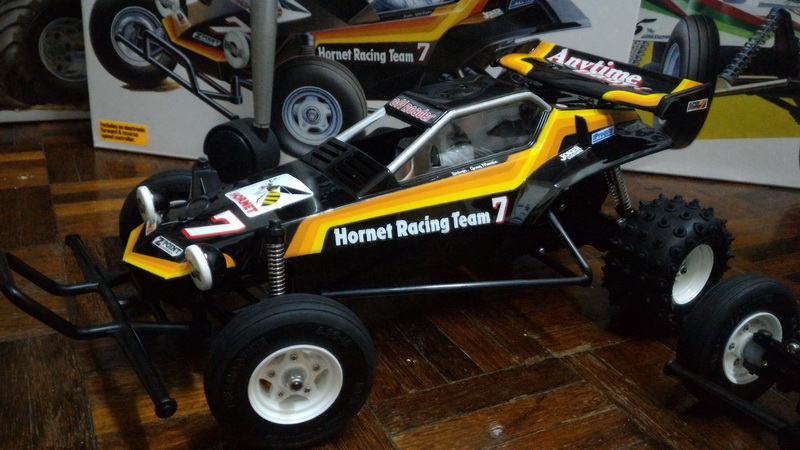
Driving performance
'The HORNET' drives and handle quite similar to its previous sibling 'The GRASSHOPPER' because both share the same chassis layout. The GRASSHOPPER is fun tame animal to drive but The HORNET has extra grunt, speed and wheelie from little bumps it encountered. Both seems to have a day and night performance in comparison despite having same base chassis which we can assume that the Grasshopper are build for beginners driving and the Hornet build for entry level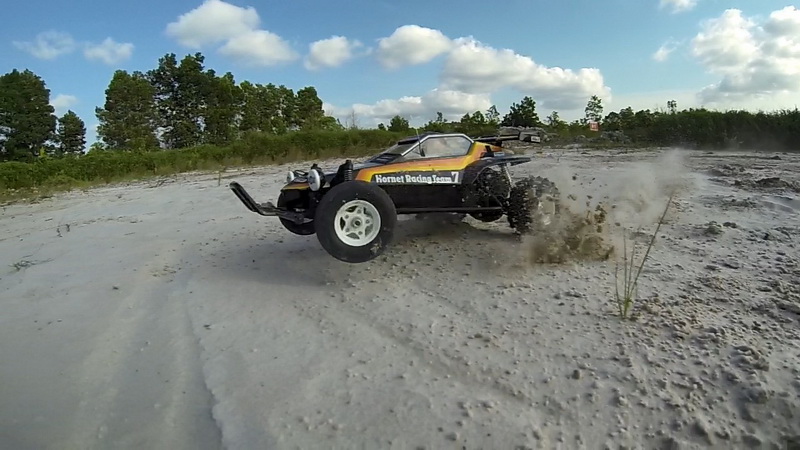 racing. The Hornet have the advantages having powerful 540 size motor for more speed and torque. It has oil filled rear shocks for smooth damping and lighter thin polycarbonate body shells for weight performance to allow low Center Gravity (CG) factor. Back in the 80's, the Hornet was build to be more competitive track racing for intermediate/entry level racer while the Grasshopper was more for first timer hobbyist although with just around $20 differences in price range between them. However by today standard after the year 2000 and beyond both buggy's day are outnumbered by modern models which have more stable driving agility, durability, speed and the advent of technological brushless motor performance. For those how own the Hornet these days are made just for drive to re-live nostalgic moments, stylish 'scale' driving, looks and personal classic collection. As for my case this buggy is still fun to drive leisurely around loose track because it has a unique fun quirks that normal modern buggies don't have....its very jumpy and playful like a kitten.
racing. The Hornet have the advantages having powerful 540 size motor for more speed and torque. It has oil filled rear shocks for smooth damping and lighter thin polycarbonate body shells for weight performance to allow low Center Gravity (CG) factor. Back in the 80's, the Hornet was build to be more competitive track racing for intermediate/entry level racer while the Grasshopper was more for first timer hobbyist although with just around $20 differences in price range between them. However by today standard after the year 2000 and beyond both buggy's day are outnumbered by modern models which have more stable driving agility, durability, speed and the advent of technological brushless motor performance. For those how own the Hornet these days are made just for drive to re-live nostalgic moments, stylish 'scale' driving, looks and personal classic collection. As for my case this buggy is still fun to drive leisurely around loose track because it has a unique fun quirks that normal modern buggies don't have....its very jumpy and playful like a kitten.
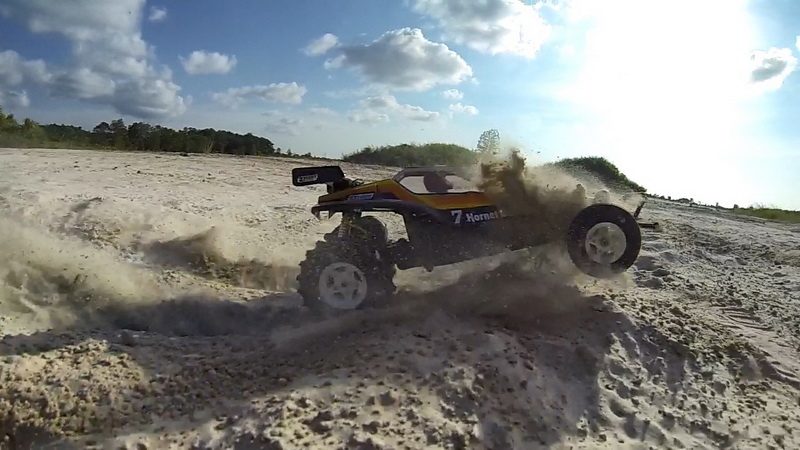
The Hornet seems to be more lively driving on loose jumpy dirt track than on hard flat tarmac, the rear puffy spikey tires for softer ground. Its a very jumpy buggy, lots of torque and its just wanted to leap off the ground after hitting any bumps along the way. The simple spring friction shock in the front helped to amplified the 'jumpiness' characteristic since it doesn't have dampers to control any rebound and the torque from 540 brushed motor coupled with high traction rear spike tires wheelies the buggy up front all the way in the air at every opportunities. The oil dampened rear shocks helps to keep landing smooth and remove and uncontrollable rebound,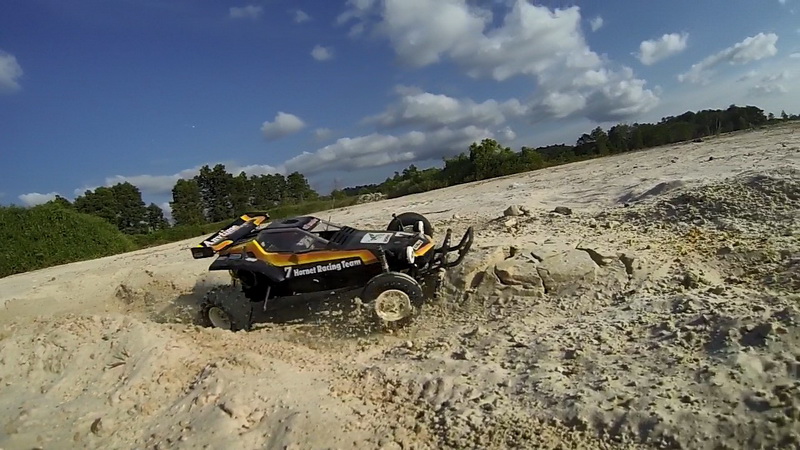 this makes rear traction more predictable than bare friction rear shocks used on the Grasshopper which hops wildly after landing hence where it gets its title from 'Grasshopper'. This makes driving more interesting and enjoy watching it getting more 'mini airtime' doing silly jumps and blasting huge amount of sands bathing it self with handful amount of fine soil all over it top bodyshell......hence make it looks photogenic through camera lens if you like to do slow mo 240 fps video capture. Driving fast straight line and then hitting the corner on loose dirt track feels like driving a rally car with 'oommpphh!!'. Slightly whippy at full throttle but it tracked very well even for a 2WD platform. Also you get to enjoy a splash amount hard solid dirt spewing sideways like a drift car leaving nothing but scorches of fresh dirt dig deeply by fat puffer fish like tires. Even my modern 4WD wouldn't be as brutal as the Hornet playing "splish splash!" with sands. If you're building a sand castle on the beach 'The HORNET' is the last thing you wouldn't want near it, it digs huge holes and leaves extremely long nasty tire marks all over, lol!...but that's the fun driving it! Hehehe! As mentioned before it will never able to win any races against modern race buggies
this makes rear traction more predictable than bare friction rear shocks used on the Grasshopper which hops wildly after landing hence where it gets its title from 'Grasshopper'. This makes driving more interesting and enjoy watching it getting more 'mini airtime' doing silly jumps and blasting huge amount of sands bathing it self with handful amount of fine soil all over it top bodyshell......hence make it looks photogenic through camera lens if you like to do slow mo 240 fps video capture. Driving fast straight line and then hitting the corner on loose dirt track feels like driving a rally car with 'oommpphh!!'. Slightly whippy at full throttle but it tracked very well even for a 2WD platform. Also you get to enjoy a splash amount hard solid dirt spewing sideways like a drift car leaving nothing but scorches of fresh dirt dig deeply by fat puffer fish like tires. Even my modern 4WD wouldn't be as brutal as the Hornet playing "splish splash!" with sands. If you're building a sand castle on the beach 'The HORNET' is the last thing you wouldn't want near it, it digs huge holes and leaves extremely long nasty tire marks all over, lol!...but that's the fun driving it! Hehehe! As mentioned before it will never able to win any races against modern race buggies due they way how the chassis was engineered back in 1980's. For what it is now its all about being playful and having fun 'free styling' driving all around the track. With stock electronic and motor setup its enough to keep me entertain on off-road track and complete the race loop without need for performance upgrades. As a basher it seem to be able to handle hard impact and knocks in all direction because the plastic suspension swing arm, shock tower, front bumper, axle gear case and base chassis are made from impact resistant plastic. Tamiya plastic feels sturdy but a bit elastic and bendy at some section which makes it resist breaking rather than being too rigid as seen in some modern day R/C kit. As usual the R/C plastic kit on TAMIYA are very reliable for 'stock ' bashing. On the down side since its an old retro chassis engineering all the suspension mechanism and rear axle pivot sounds very clunky with plastic pivot rattle around as it goes over bumpy terrain, not smooth and silent as modern chassis does.
due they way how the chassis was engineered back in 1980's. For what it is now its all about being playful and having fun 'free styling' driving all around the track. With stock electronic and motor setup its enough to keep me entertain on off-road track and complete the race loop without need for performance upgrades. As a basher it seem to be able to handle hard impact and knocks in all direction because the plastic suspension swing arm, shock tower, front bumper, axle gear case and base chassis are made from impact resistant plastic. Tamiya plastic feels sturdy but a bit elastic and bendy at some section which makes it resist breaking rather than being too rigid as seen in some modern day R/C kit. As usual the R/C plastic kit on TAMIYA are very reliable for 'stock ' bashing. On the down side since its an old retro chassis engineering all the suspension mechanism and rear axle pivot sounds very clunky with plastic pivot rattle around as it goes over bumpy terrain, not smooth and silent as modern chassis does.
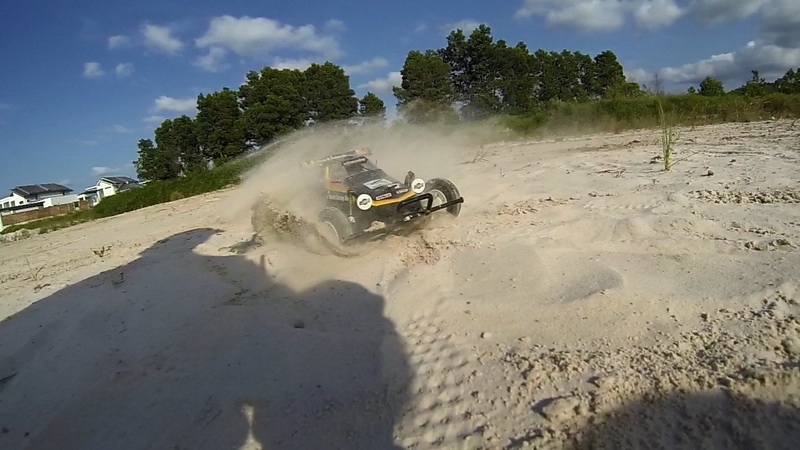
Powering my Hornet i'm using 7.4V 2S 2200mah 35c Li-po pack which is good enough for 20 minutes of sand bashing with conservative push on the throttle. Its consume slightly more battery current due to its 540 performance size motor as oppose to 380 size on stock Grasshopper. Noted that 540 motor size is standard in todays 1/10 scale R/C models while 380 most used by scale R/C model between 1/14 and 1/18 stock racers. Accessing battery compartment is far easier than that of modern R/C models; the battery compartment on the Hornet is accessible under the base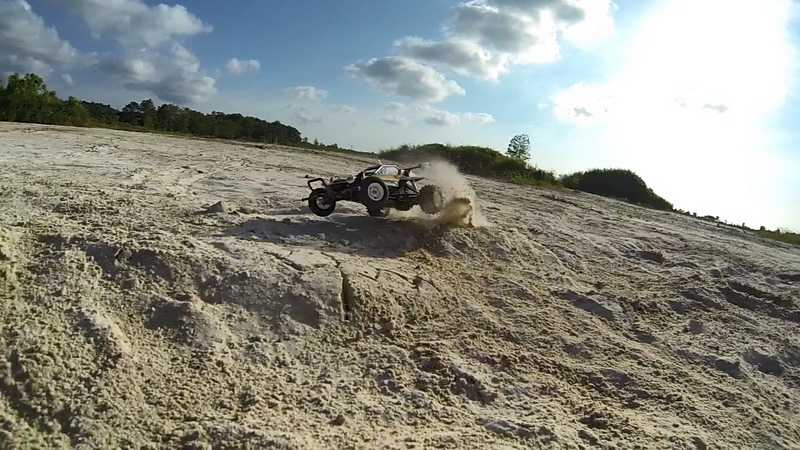 chassis where you just flip it upside down with the bottom facing upwards, just slide open the hatch and swing the battery lid up which is why i love the simplicity of older classic buggy. It makes task easier to run the buggy; open the latch, plug the battery in, close and run it!.. all in less than 10 seconds of preparation to run. I hate the body shell latching pins on modern buggies, too much work and hassle just to open the whole body shell and install a battery which takes around 2 minutes to prepare....classic engineering rocks! Since its just a 2WD most of its gears, differentials, spur gear, and drive shaft outer wheels hubs are fully sealed inside one huge rigid box of axle indeed it need less cleaning and maintenance works since dust and sand hardly enters into the moving gear parts unlike independent suspension gearboxes which is why they are the best for driving on serious dirty tracks, sands and wet stuff.....as i get older i hate having my time being rob on doing cleaning and maintenance. This is why i love running 2WD at sandy beaches than on 4WD.
chassis where you just flip it upside down with the bottom facing upwards, just slide open the hatch and swing the battery lid up which is why i love the simplicity of older classic buggy. It makes task easier to run the buggy; open the latch, plug the battery in, close and run it!.. all in less than 10 seconds of preparation to run. I hate the body shell latching pins on modern buggies, too much work and hassle just to open the whole body shell and install a battery which takes around 2 minutes to prepare....classic engineering rocks! Since its just a 2WD most of its gears, differentials, spur gear, and drive shaft outer wheels hubs are fully sealed inside one huge rigid box of axle indeed it need less cleaning and maintenance works since dust and sand hardly enters into the moving gear parts unlike independent suspension gearboxes which is why they are the best for driving on serious dirty tracks, sands and wet stuff.....as i get older i hate having my time being rob on doing cleaning and maintenance. This is why i love running 2WD at sandy beaches than on 4WD.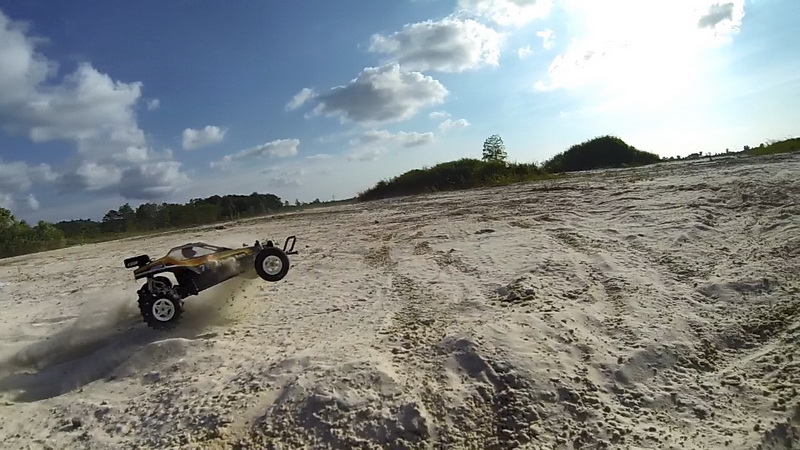
Should i upgrade my Hornet with hop-up parts? If i would go down on this route i would only upgrade the wheels and tires of on-road fun driving and keep everything stock... that's it. Upgrade to brushless can be fun for bashing too but the agility and stability will be affected severely because the way how the chassis and stumpy suspension design. The CG (Center Gravity) for this buggy is quite high compare to modern race buggies. You'd likely to roll at certain turns with brushless power if not careful and any bumps would tumble the Hornet around. However on sand terrains like beach area the Hornet do shines with brushless motor upgrades. To sum up any upgrades on the Hornet for competitive use on the track it will not gain much against modern day buggy. However you're not limited to upgrade it if you're going for looks or for shelf queen purposes. Just go wild with your imagination.
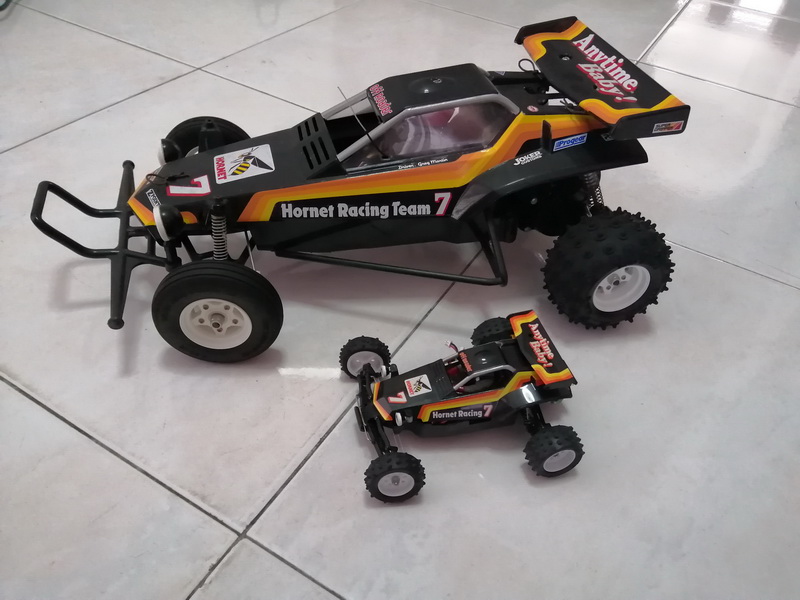
Aesthetic value
The HORNET does look good on my wooden shelf; has style and premium looks of authentic scale dune buggy than cheap toyish looking R/C buggies that you would find from normal R/C shop. It looks 'sharp' and most importantly it speaks 1980's with just a glance as you walk pass by it. In fact The HORNET has become most recognizable buggy design when people think of classic R/C dune buggy. Its pretty much close that what realistic down to earth dune buggy should look like mirroring nearest cousins like the HPI's BAJA 5B, TAMIYA's The FOX, HOTSHOT, GRASSHOPPER and KYOSHO's SCORPION and OPTIMA series. Long nose chassis, roll caged cockpit, short stumpy hatch back like rear where the engine is at and retro spikey tires for some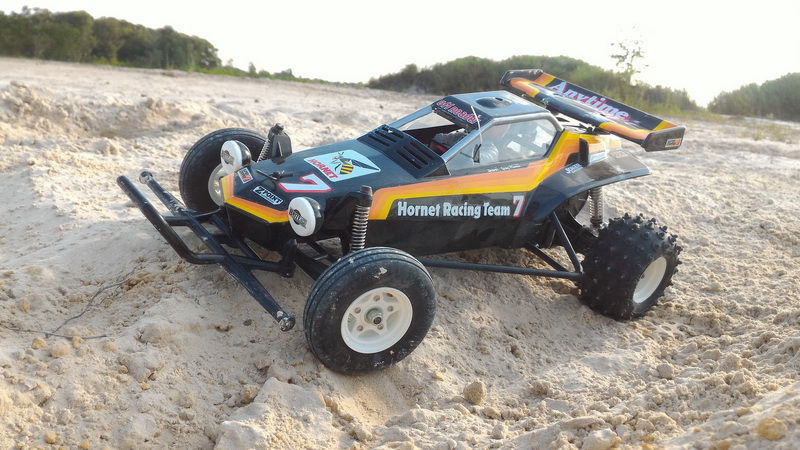 serious sand digging action. These are what real off-road buggies should be. For the HORNET it has generic classic looks of an typical real life off-roader, mechanically simple, looks rugged, has photogenic qualities, very logical in design and the wheels scream 'dirt blaster' all over. Together along with 'The Grasshopper' it also has sharper and solid body shell contour which makes it looks more premium R/C buggies in comparison to newer modern models in the market...that's the quality of R/C we would get in 1980's!...sucks to be in 2022 though for any R/C off-roader enthusiast, lol! But if you trace back the lineage root of TAMIYA and MARUI brands history they all started as plastic kit models before jumping into radio control models scene which explained its solid aesthetic features and kit like build.
serious sand digging action. These are what real off-road buggies should be. For the HORNET it has generic classic looks of an typical real life off-roader, mechanically simple, looks rugged, has photogenic qualities, very logical in design and the wheels scream 'dirt blaster' all over. Together along with 'The Grasshopper' it also has sharper and solid body shell contour which makes it looks more premium R/C buggies in comparison to newer modern models in the market...that's the quality of R/C we would get in 1980's!...sucks to be in 2022 though for any R/C off-roader enthusiast, lol! But if you trace back the lineage root of TAMIYA and MARUI brands history they all started as plastic kit models before jumping into radio control models scene which explained its solid aesthetic features and kit like build.
Extra note: based on my observation on all R/C buggies on local and online market 'The HORNET' body and chassis design takes the top spot for the most cloned/copy model used as references to produce variant of R/C off roader from 1/10 scale in the year 1980's (Hint: RADIO SHACK - GOLDEN ARROW) to present day micro size (Hint: 1/43 GREAT WALL - 2209)......i'm still hunting online for '2209' unit so wish me luck! In 2022 i've manage to build a replica 1/32 scale micro Hornet base on LT832 chassis (aka Losi Micro-T). Both looks stunningly good on the shelf like Father and Son! And so my shelf queen was plenty with retro replicas! hehehe!
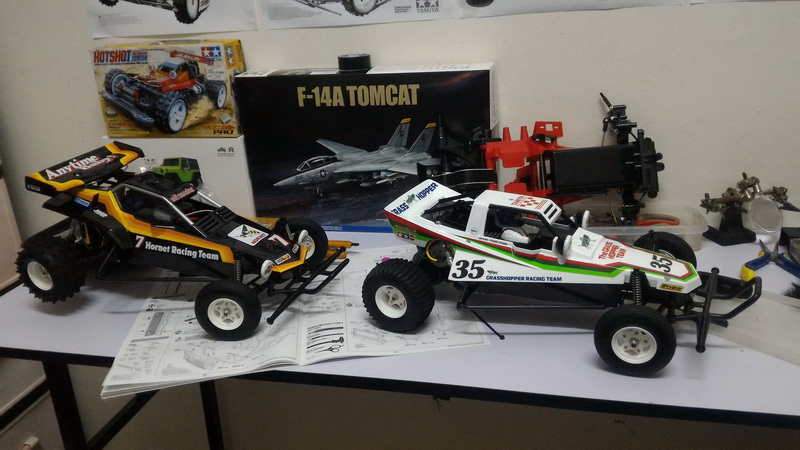
Videos/Medias![]() Here are sample of video of i posted on my Youtube channel contain fun driving & bashing around my TAMIYA HORNET.
Here are sample of video of i posted on my Youtube channel contain fun driving & bashing around my TAMIYA HORNET.
- Product gallery: 1/10 Tamiya: THE HORNET
Vendor/seller
Here are list of reputable vendor/seller which i bought from and also verified by community forum discussion groups. Also i've experienced buying from these places that have good support and services:
- Seller Rcmart.com (East Asia): 1:10 scale Tamiya: The Hornet (Re-released 2004)
- Seller Asiatees.com (East Asia): 1:10 scale Tamiya The Hornet (2004)
**Note: There are many vendor/seller for TAMIYA models around the globe but the above is closest to my country in east asia.
Support group/articles:
Places where you can find help and resources related to this product:
Company website: https://www.tamiya.com
Wikipedia TAMIYA CORPORATION: https://en.wikipedia.org/wiki/Tamiya_Corporation
Tamiya 1984 THE HORNET specification sheet: https://tamiyabase.com/tamiya-models/58045-58045
Tamiya 2004 re-release THE HORNET specification sheet: https://tamiyabase.com/tamiya-models/58336-58336
Tamiya TBLE-02S Speed controller module support: https://www.tamiyausa.com/shop/electronics/rc-esc-tble-02s-brushless/
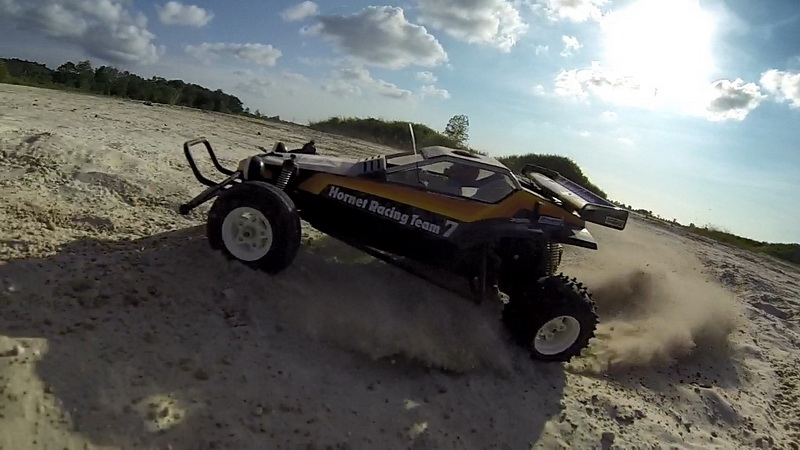
Summary
Its 2022 at the time of writing this article, would i regret owning an old vintage buggies?...nope, i'm loving it! Of course i bought The HORNET not only for nostalgic childhood factor full filling my 'life bucket list' but as an R/C off-road buggy enthusiast this model looks aesthetically more 'premium' for its down to earth scale looks of a true off-road buggy. Having one completes the path of righteousness being an avid R/C buggy enthusiast among the community...its like bee without seeking honey. Today modern R/C buggies lacks of such 'looks' making them looks like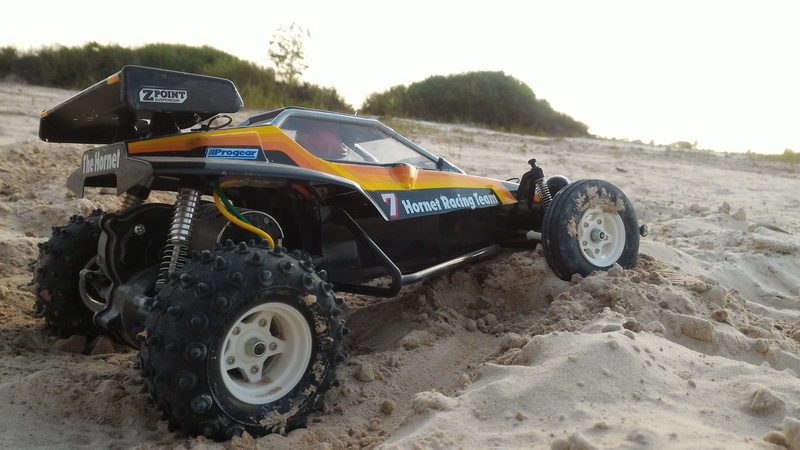 unrealistic hybrid F1 off-road car on off-road tires. When you scale them to 1:1 they don't look so 'credible' being part of scale motorsport vehicle. Which is why nowadays R/C rock crawlers prefer scale trucks with real replica bodies like Land Rover or Hilux to replica real world motorsports. Scaler looks matters!
unrealistic hybrid F1 off-road car on off-road tires. When you scale them to 1:1 they don't look so 'credible' being part of scale motorsport vehicle. Which is why nowadays R/C rock crawlers prefer scale trucks with real replica bodies like Land Rover or Hilux to replica real world motorsports. Scaler looks matters!
Almost daily i would always stand in front of the shelf where THE HORNET sit, visible next to the sofa where i watched TV everyday. I would stare at it with a big smile, its not about satisfaction for having an R/C toy but its all about how far my life have been life from 1984 to present day. Wow! here i am in 2022 still kicking in my 40's age where my other sibling, friends and relative still struggling hard times...unfortunately some of them just pass on to the 'after life'. You cannot turn back time but you can own pieces from the past thus this model reminds me well. As R/C hobbyist grew older each passing year, one day you'll be looking at these relic model as proud achievement of your life that you've lived that 'moments'. As for me i've completed my goal and ticked bucket list of my childhood dream! That hope to own this great classic R/C models that i craved in the past was a success fullfillment!. Okay maybe i'll dig in HOTSHOT or FOX (Nova Fox) for my next projects! hehehe!. We oldies need something to have fun in spare time, looking forward to keep me busy on my next future R/C kits.
